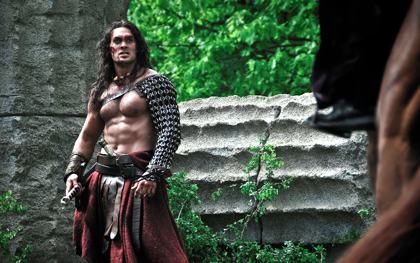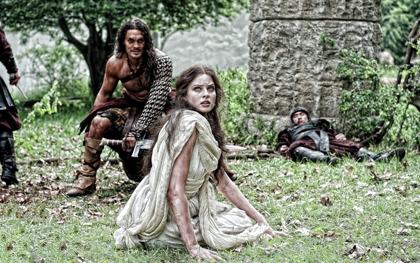Review
Conan the Barbarian

Nick Pinkerton finds director Marcus Nispel and star Jason Momoa’s re-adaptation of the Robert E. Howard barbarian yarn is sans tissue, sans weight, sans identity and sans Arnie
Conan the Barbarian
USA 2011
Director: Marcus Nispel
With Jason Momoa, Rachel Nichols, Stephen Lang, Rose McGowan, Saïd Taghmaoui, Ron Perlman, Leo Howard
112 mins | Cert 15
Synopsis
Our synopses give away the plot in full, including surprise twists.
Cimmeria, the Hyborian Age. A baby is born in the midst of battle and his warrior mother killed. The child, Conan, is brought up by his father, and from an early age shows a remarkable instinct for war. The young Conan’s father is killed by a raiding party.
As a young man, Conan seeks out his father’s murderers. He meets and becomes the protector of Tamara; she has been chased from her monastery by Khalar Zym and his sorcerer daughter Marique, who need her royal blood for a ritual that grants immortality. Khalar and Marique are also, in fact, the murderers Conan has been seeking. Conan attempts to lead them into a trap using Tamara as bait, but he is thwarted by Marique’s magic. When Tamara is taken captive, Conan breaks into Zym’s fortress and disrupts the sacrificial ceremony. Zym and Marique are vanquished in an epic battle. Conan reinstates Tamara at the monastery.
Review
There is a memorable scene in the 1982 film of Conan in which Robert E. Howard’s barbarian hero, as incarnated by a young Arnold Schwarzenegger, is shown under the slave driver’s lash, harnessed to a massive millstone that he must turn in perpetuity. Like much in John Milius’s film, this is a bit ridiculous – what does that wheel do anyways? – but it also functions as a primal, powerful image, devised by someone who understands myth: Superman in bondage.
There is no equivalent scene in Marcus Nispel’s relaunched or remade or rebooted Conan. When Jason Momoa’s Cimmerian, in an early scene, leads a raid on a slaver’s camp, his fury at the sight of men in chains is merely the sign of a noble personality, with no hard, physical resentment behind it. It’s representative of shortcut filmmaking, in which narrative tissue is liposuctioned out to create more room for sword-swinging spectacle, with a dulcet Morgan Freeman voiceover that puts one in mind of penguin documentaries.

It is right that a new Conan film must look for its own identity, but one immediately notices that in the absence of Milius’s saga-paced direction, Basil Poledouris’s martial, huffing soundtrack and Schwarzenegger’s special-effect physique, very little has been introduced to replace them. This Conan the Barbarian is in ‘3D’, but the technique is so little in evidence that I very much doubt any viewer would notice if not alerted to it by the poster and an irritating pressure on the bridge of the nose. Where the film should rebuild Howard’s world from the ground up, this Conan rests on its inscribed audience’s presale memories.
For backstory, we have much material involving son Conan and his father, played not surprisingly by Ron Perelman, and a scene in which a preteen Conan shows off his precocious fighting poise by flying into a pack of hostile tribesmen with wolverine-like ferocity, sending them off one after another accompanied by much crunching of gristle and bone. The film has impact – you can’t deny that of something that begins with a newborn child being plucked out of a sword wound – but this is not the same as having weight. Momoa, peering between sheets of hair, practises a glower and a feline grin but hasn’t the Frank Frazetta-painting-made-flesh visual impact of his predecessor, while the setting remains as faint as the dramatis personae – one experiences less a diverse, physical world that the cast are questing through than a flipbook of establishing shots of castles and kingdoms, fantasy-art postcards.
Nispel is a commercial director whose career largely consists of remaking famously gory titles (The Texas Chainsaw Massacre, Friday the 13th), and his work here is roundly competent if precious little else. He cuts with the action, and he shoots the sanguinary swordplay lucidly, so you can tell who’s thrusting what in to whom.
Where Conan fails is in giving the viewer the slightest encouragement to care about that what and whom. What entertainment there is comes from the played-up camp elements: the incestuous interplay between Stephen Lang and Rose McGowan as warlord Khalar Zym and his daughter Marique; the Cro-Magnon way Conan has with the opposite sex, dragging Rachel Nichols’s Tamara from kingdom to kingdom with monosyllabic disregard; the chunks of hoary Howard dialogue (“I live, I love, I slay and am content”) that serve no purpose but to look good in the trailer. But Conan is no great shakes as a comedy either, and it is worth noting that Your Highness, David Gordon Green’s parody of Dungeons & Dragons medievalism, got closer to the brawny emotions of a good quest film than this grave, trivial tribute.
See also
How to tell a true war story: Nick Pinkerton on how Hollywood’s auteur generation distilled the Vietnam War into a new form of vigilantism (May 2011)
Thor reviewed by Kim Newman (April 2011)
Die Hard 4.0 reviewed by Kim Newman (August 2007)
End of Days reviewed by Mark Kermode (February 2000)
